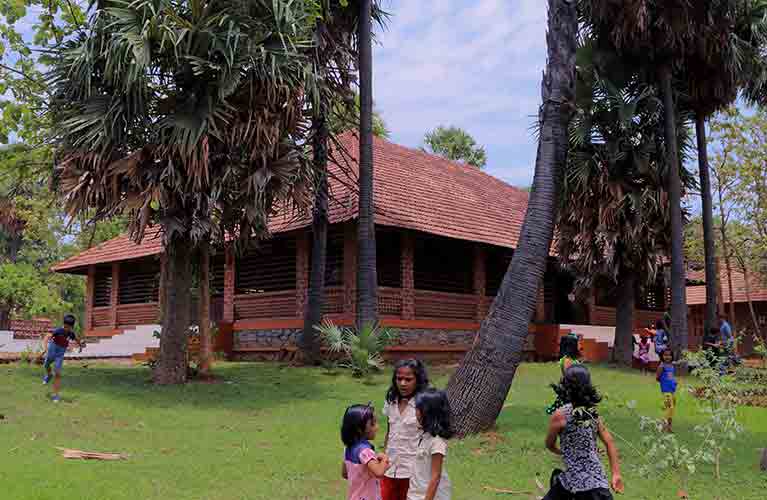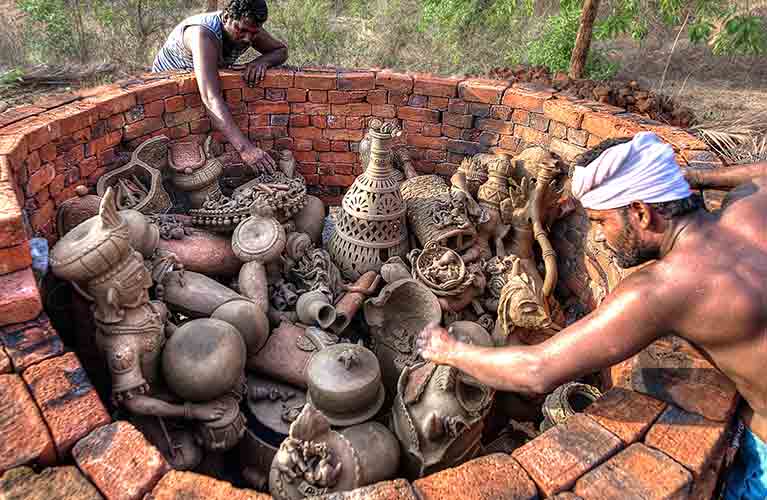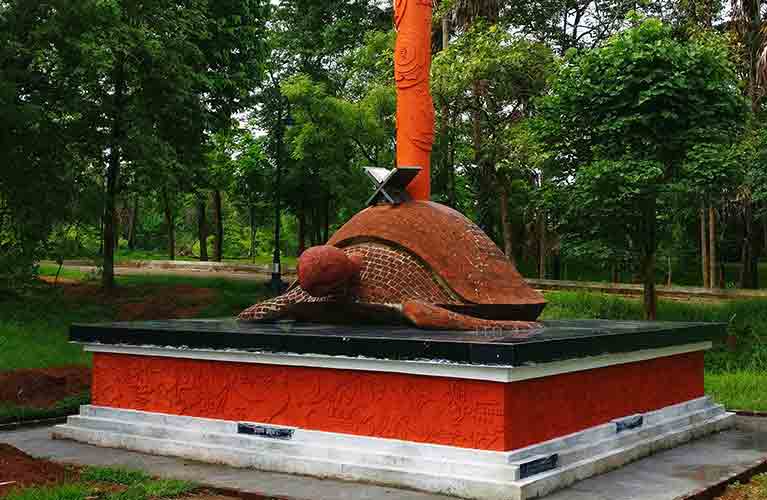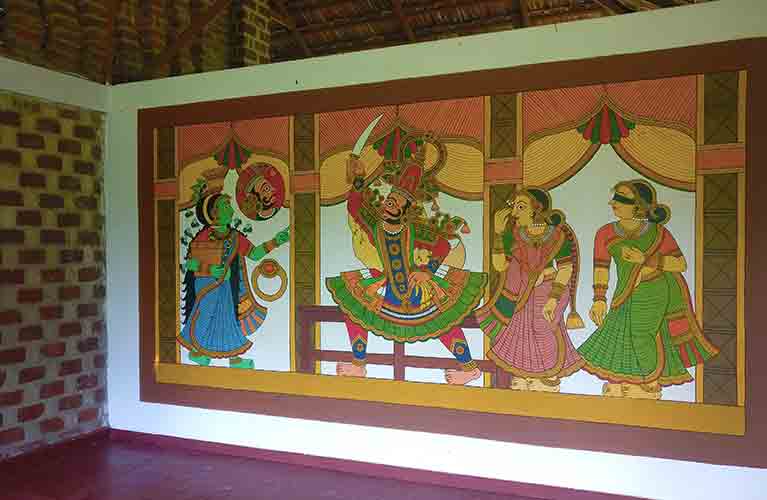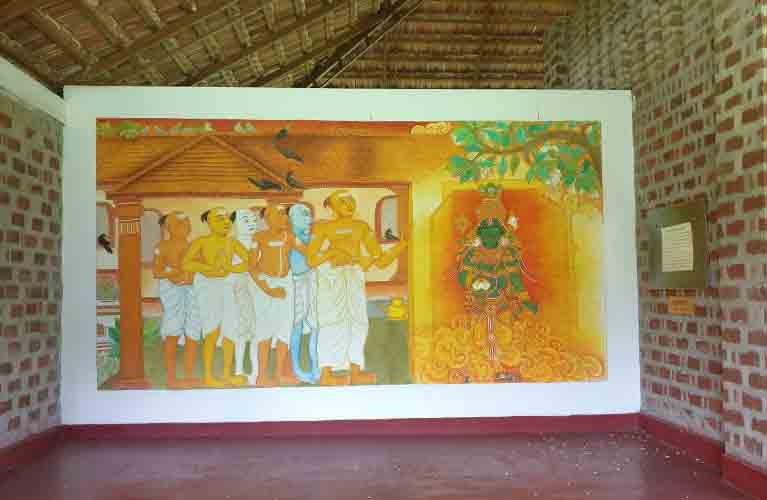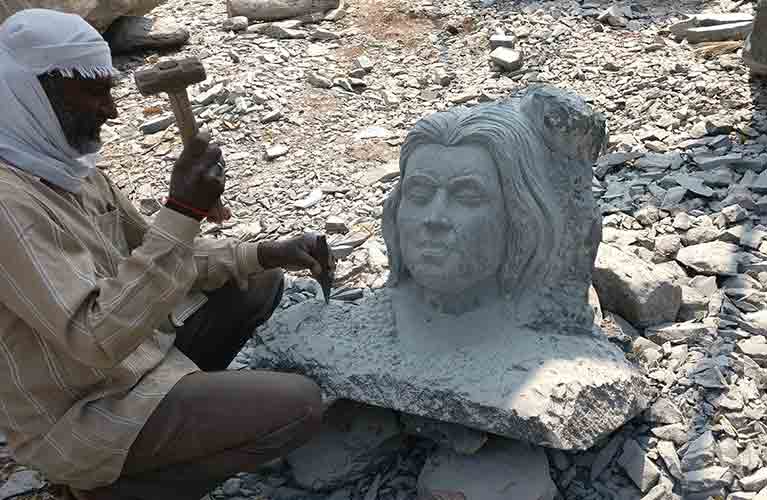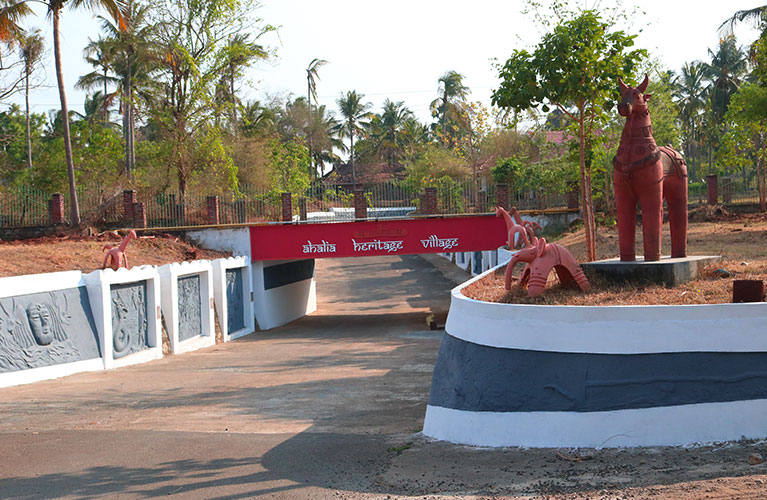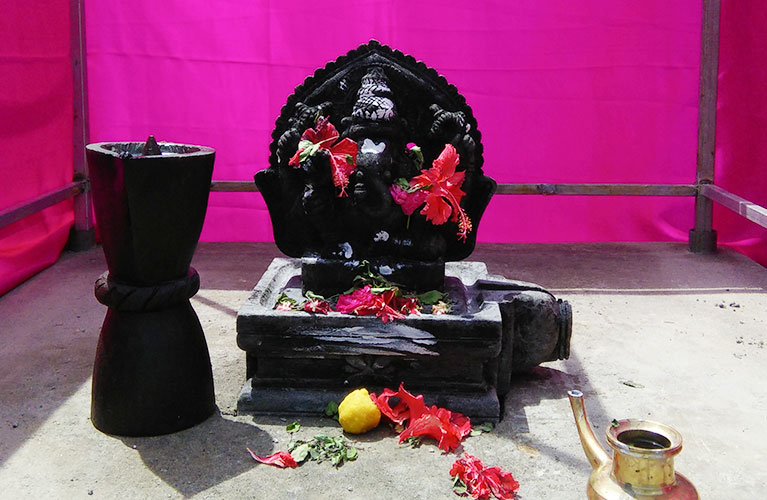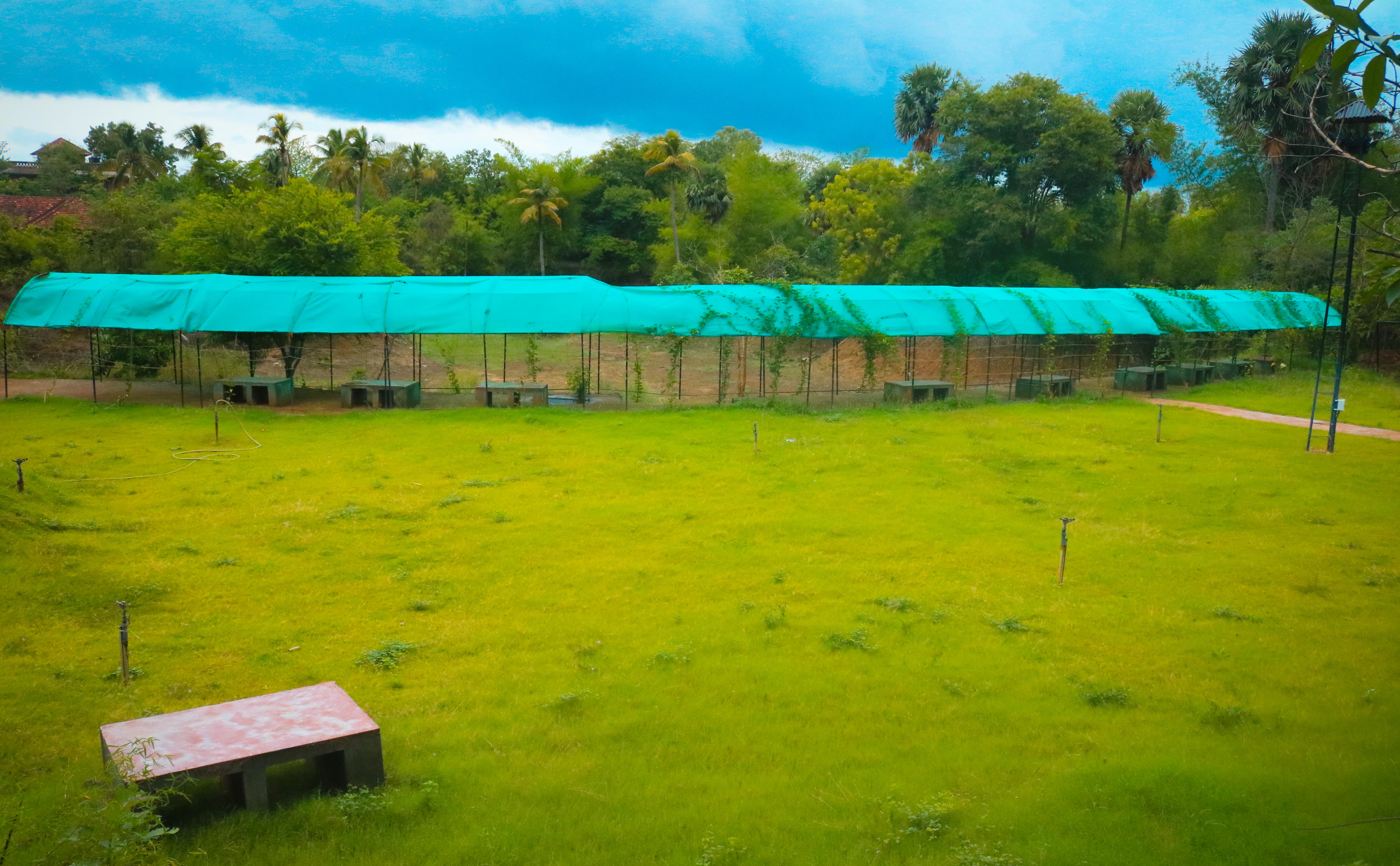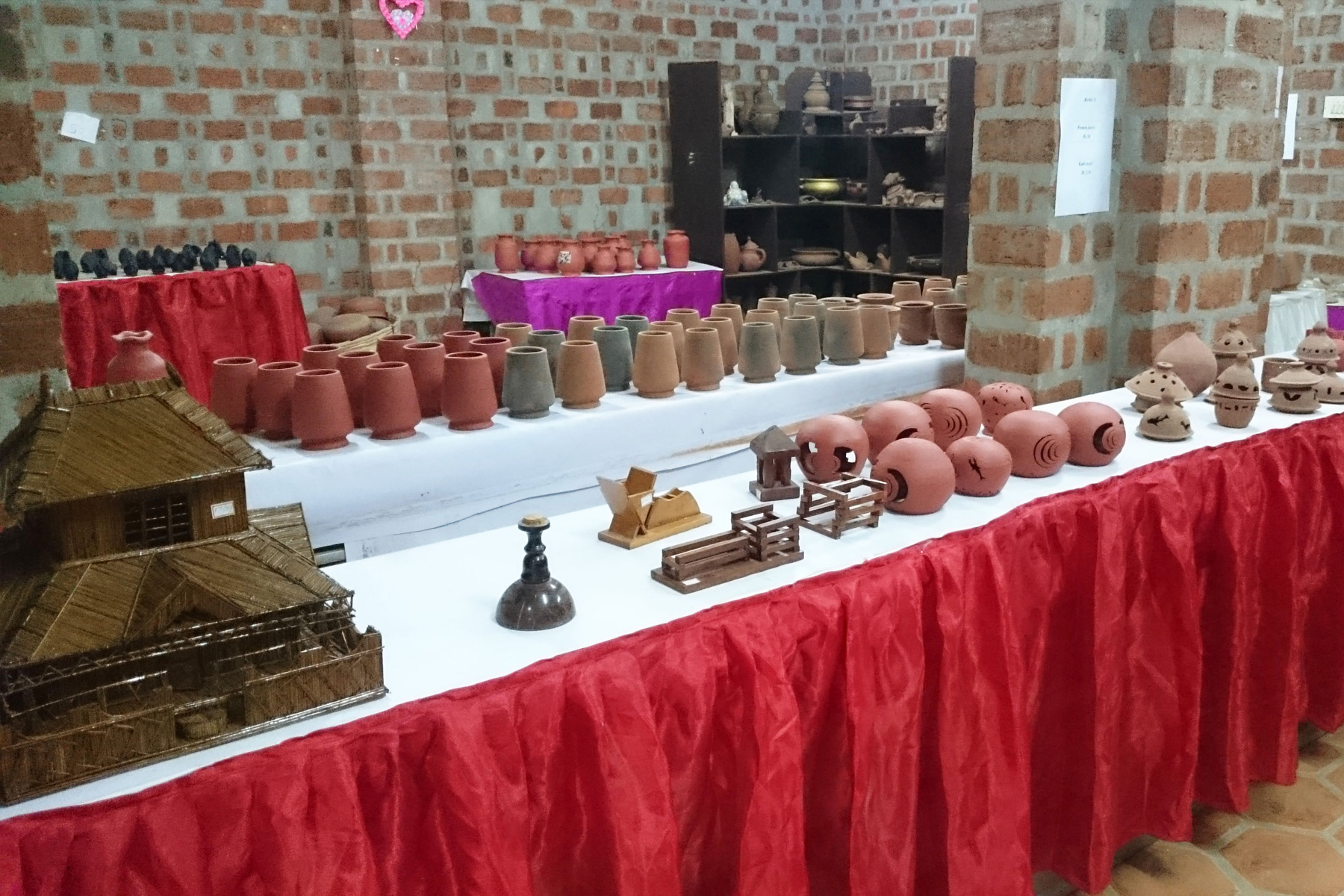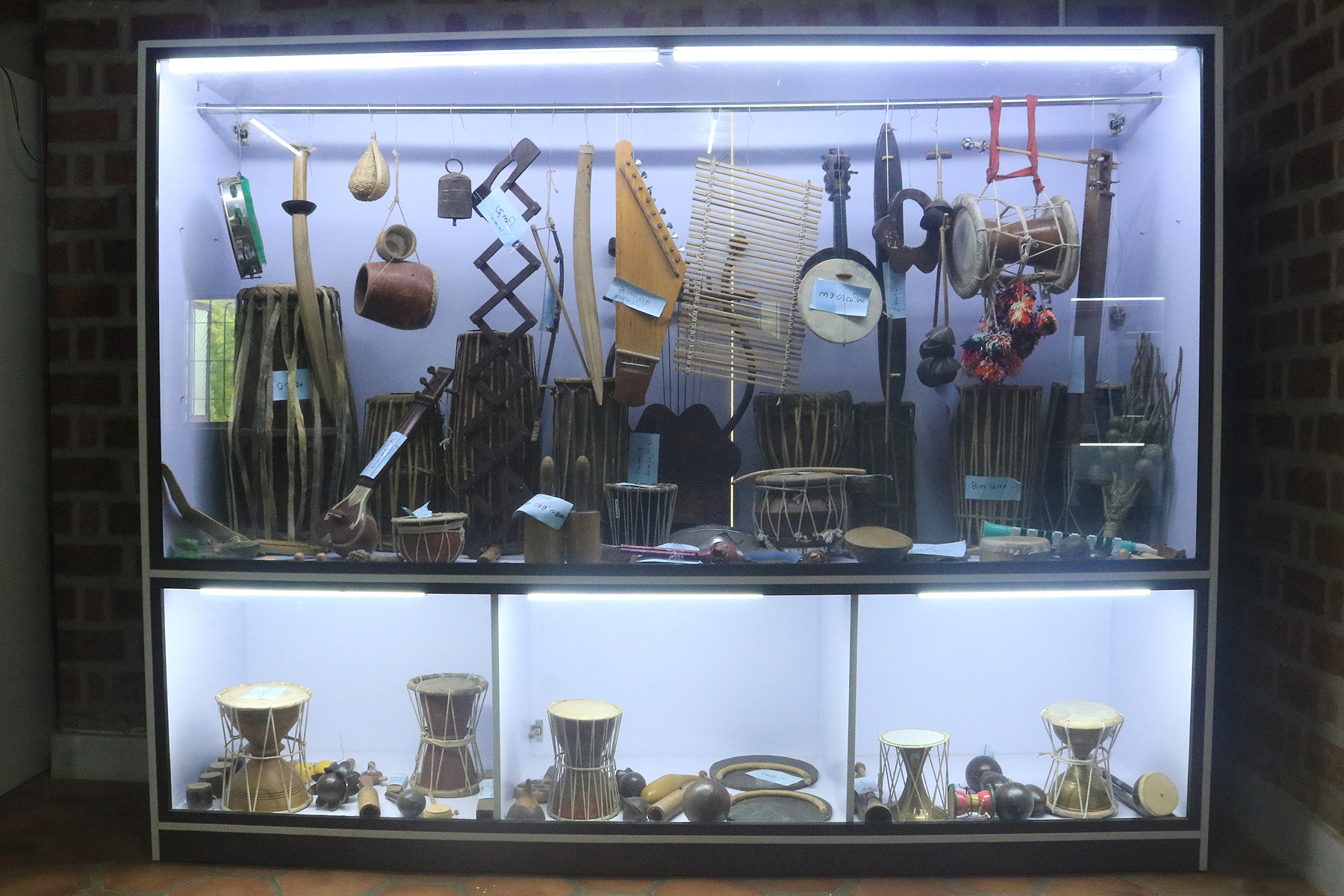At our campus, we provide experiences for the novice as well the connoisseur. Some of the experiences we provide are listed below. This, however, constitutes only about half of what we can offer the discerning individual. Please click <here> for a list of all the attractions at the Heritage Village.
Koothambalam & Aniyara
The Koothambalam lies at the heart of the performing arts of Kerala, literally and figuratively. It is the traditional performing arena for iconic arts forms like Koodiyattom and Chakyarkoothu . We have recreated such a space here, with all its attached mystique and aura. The Aniyara is the ancient equivalent of the modern green room, and is the place for the artiste to get ready for her performance.
Terracotta Sculpture Museum
Consisting of more than five hundred pieces of terracotta artwork created by artists representing the length and breadth of India, this museum provides a snapshot of India's intellectual, cultural and historic heritage.
Bust Park
Celebrated theatre personalities, social reformers, musicians and literary figures from across the world are memorialized in our own little busts park.
Knowledge Pillar
Mounted on a pedestal representing Chathurvedas - Rigveda, Yajurveda, Samaveda and Atharvaveda- which are the first sources of knowledge to mankind is the Tortoise which is the symbol of wisdom and longevity. In Asian as well as other cultures tortoise is regarded as the wise creature. According to Indian mythology, the entire world rests on the back of four elephants standing on the shell of a tortoise. The tortoise bears a pillar representing sushumnanadi(spinal cord) with shadchakras, the energy centers of the subtle body namely, Muladhara, Svadhishtana, Manipura, Anahata , Vishudhi and Ajna further leading to the Sahasrarapadma, the thousand petalled lotus, representating enlightenment. The pillar is an abstract depiction of knowledge and enlightenment on the whole.
Alwars
Alwars are the Tamil poet saints venerated especially in Vaishnavism. Believed to date back between 5th century AD and 10th century AD, their devotional outpourings revived Bhakti movement filled with love and bliss. They are widely regarded as twelve in number where Andal is the only female Alwar and are believed to have promoted the Bhagavatha cult. Here the twelve Alwars are represented through creative portrait sculptures in granite.
Granite Sculpture Park
This park has over thirty sculptures, some of which are up to 20 feet in height. The park is built around the theme of womanhood and has sculptures of figures from Indian myth and legend like Ahalia, Draupadi and Kannagi.
Tribal Mural Gallery
11 tribal mural paintings from different states of 8×12ft size echoing local and regional legends are portrayed in this gallery. Warli painting, Pattachitras of Odisha and West Bengal, Cheriyal scroll painting, Gond painting, Kurumba painting etc are only a few to name. Each painting is a reflection of the life and legends prevalent among the tribe. The Warli and Kurumba paintings are a clear portrayal of daily life of the tribes including their celebrations and festivals. The Pattachitras are usually done on clothes, as the the name suggests. The West Bengal Pattachitra depicts local legend of deity Manasadevi.
Parayipetta Panthirukulam
Parayipetta Panthirukulam - the 12 castes born from a Parayi- is probably the most significant among the myths and legends of Kerala. Vararuchi and his wife Panchami who is a Parayi by caste, sets off a pilgrimage during which she gives birth to twelve kids. Upon Vararuchi's insistence, she abandons them only to be found and adopted by families of different caste and they grew as stalwarts in their respective caste. The twelve, namely Mezhathol Agnihotri, Pakkanar, Perumthachan, Rajakan, Vallon, Vaduthala Nair, Uppukkoottan, Akavur Chathan, Karakkalamma, Pananaar, Naranathubhraanthan and Vaayillakkunillappan are still the most celebrated characters along Thrissur, Palakkad and Malappuram districts of Kerala. Twelve Kerala mural paintings each of 8×12ft size is depicted to convey their stories.
Sthrainam Sculpture Park
Sthrainam is the depiction of womanhood from myths, legends and literature. Sculpted out by sculptors from across different states, the rock garden is one of its kind in the state and the only one arguably in the entire country celebrating the theme of WOMANHOOD. Sculptures narrate stories of Kannagi of Silappathikaram, the earliest Sanghakala work and Savithri who won back the life of her husband Satyavan from Yama. The Panchakanyas- the five virgins- mentioned in myths- Ahalya, Draupati, Sita, Tara and Mandodari are also planned.
Entrance
UNDER PASS NOT JUST A PASSAGE BUT A THRESHOLD TO TIME & CIVILIZATION
The entrance of Ahalia heritage village is known as under pass.Here you are about to experience the past the relief works on both sides based on the themes water and time through MANWANTHARAS(AN AGE CALCULATION METHOD OF INDIAN PURANAS) According to Indian mythology, Brahma, the creator is depicted holding a water pot or kamandalu for it was in water the first seeds of creation was sown. This attributed divinity of water succeeds to find its slot in rituals of almost every religion of the world. In Hinduism, it is believed that water has spiritually cleansing powers. To Hindus, there are seven sacred rivers. After cremation, the ashes are cast onto these holy rivers that would bestow the spirit the ultimate liberation.
In Judaism, ritual washing is done to restore or maintain a state of spiritual purity. In Buddhist funerals, water is poured into a bowl placed before the monks and the dead. As it overflows, the monks recite, ‘As the rains fill the rivers and overflow into the ocean, so likewise may what is given here reach the departed.’ A combination of purifying properties of water and its importance as a fundamental life element is clearly mentioned in Zoroastrianism. Almost all Christian churches or sects have an initiation
ritual involving the use of water. Waterfalls are held sacred and standing under them is believed to purify in Shintoism. Believers of Islam make themselves ritually pure before offering prayers.
In many cultures, water is the ultimate healer of diseases as well. Temples of Chidambaram (Tamil Nadu) echoes stories of Vaitheeswaran, who is Shiva himself, who cured leprosy of Mars by asking him to take bath in the holy pond, siddhaamruthatheertha. Achilles, the great warrior in Greek mythology is dipped into river Styx by his mother Tethys and for this reason alone he prevails unconquerable.The beginning of civilizations and settlements despite the geographical
differences always centered a greater source of water, the rivers. Indus
valley civilization around Sindhu and Mesopotamia around Euphrates and
Tigris are only a couple to name. The waters affected not only the
settlements but development of an entirely new way of life among a previously nomadic hunter gatherer population with agriculture as foci. Over time, the Egyptians and Mayans also learned on importance of water. The flooding of rivers during spring became the foundation of their measurement of time and economic structure based on which they harvested crops. The people measured water levels of Nile and altered taxations with them. As time passed, humans mastered in directing water to themselves rather than moving around for water. Dams, aqueducts and reservoirs were built for massive water storage. Egyptian and Indus valley civilizations are renowned for their advanced drainage systems based on gravity. This forever changed the phase of human settlements.
The gone age of forefathers pivoted on water, and lives defined by rivers. With all sort of advancements, current scenario is different. It is shocking rather than surprising to notice the change in attitude that evolved with passage of time. The quality of rivers depend on the number of humans settled around. Ultimately, what is about to bring a change is how early is that moment of introspection prior to his realization about the nature. Here is a depiction of certain aspects of civilizations that developed along
riversides.
Saptarishis
1.KASHYAPA WITH DITI- By DEEPU MOHAN
Kashyapa, the father of Devas, Asuras and the entire humanity is portrayed as being seduced by his wife and daughter of Daksha, Diti. Overcome by lust one evening Diti approached Kashyapa. He, however, told Diti that evening was inauspicious as it was the time ghosts and demons wandered. Upon wife’s insistence, knowing the course of fate, Kashyapa fulfilled her desire leading to the birth of the two demons Hiranyaksha and Hiranyakashipu from whom the entire race of asuras grew.
2.KASHYAPA& JALOLBHAV
According to Kalhana’s Rajatarangini, the valley of Kashmir had a large lake called satisaras, inhabited by a demon called Jalodbhav. As it started killing people of the region, the king pleads Kashyapa for help. Kashyapa approaches Vishnu and Ananda drains off the lake. Vishnu captures and kills Jalodbhav with his sudarshanchakra. Kashmir is named after him, ‘kashyapa+mira’, which means ‘lake of Kashyapa’.
3.ATRI
The relief depicts Atri in meditation. Atri and Anasuya performed deep penance at the drought striken forest of kamad for rain. Once, in the midst of penance when Atri demanded water and Anasuya could not find, Ganga offered water. All deities were pleased by their penance and blessed them, whereas Ganga promised to stay in exchange for all the virtues of the penance attained in an year. The ganga is shown flowing.
The trinity once decided to test virtue of Anasuya. They visited their hermitage and demanded Anasuya to feed them nude. Anasuya, with all her austerities, converted them into kids and fed. The trinity, however, impressed by her serenity, blessed her with offsprings. Soma from Brahma, Dattatreya from Vishnu and Durvasva from Rudra was born. Later, a boon was given that the trinity would merge into Dattatreya. Atri, in a war between devas and asuras is said to have transformed himself into sun and the moon.
4.ATRI & SWARBHANU- By Saji
Atri’s power to dispel solar eclipse is seen. When once Swarbhanu, the asura responsible for solar eclipses, engulfed Surya, Atri rediscovered Surya with four verses of prayer. Swarbhanu’s magic disappeared and Surya was established in heaven.
5.VASISHTA & NANDINI
Vasishta’s wish granting cow, Nandhini was gifted by Indra. Admiring the auspiciousness and aware of its abilities, Kaushika, a king, attempts to possess the cow. However, Vasishta destroys his entire army by chanting ‘ohm’. Another version suggests that Nandhini comes back to Vasishta by herself from the palace of Kaushika, out of affection. It is to attain Nandhini alone that Kaushika leaves for forest and performs tapasya. Kaushika, later with powerful meditation becomes Vishwamitra, a constant rival to Vasishta.
6.VASISHTA &NANDHINI- By Johnson
Vasishta and nandhini are portrayed in front of his ashram. Nandhini is widely considered as the daughter of Kamadhenu. Whereas, some also suggests that Nandhini is Kamadhenu itself. Its origin traces back to samudramanthan from which the cow was given to the saptarishis by devas. It in course of time came to be possessed by sage Vasishta. Its complexion is explained as that of white clouds. Each part of the cow is of religious significance.the four legs symbolize four Vedas and its teats Purusharthas. Its horns symbolizes gods, face the sun and moon and its shoulders agni.
7.VISWAMITRA & MENAKA- By Johnson
The relief shows Menaka attempting to tempt Viswamitra away from his penance. Indra, afraid if Viswamitra’s powers would overpower his, sent apsara Menaka to lure him. Menaka succeeded but only until Viswamitra came to reject her after he became aware of Indra’s plan and returns more ardently into his practice. Indra, again sent apsara Rambha to distract him. She is cursed by Viswamitra to become a rock for 10,000 years. Viswamitra, however realizes that his real enemy is himself and finally wins the title of Brahmarishi.
8.GAUTAMA WITH AHALYA, BRAHMA & KAMADHENU
Ahalya, the daughter of Brahma was brought up in the ashram of sage Gautama. When time had arrived to have her married, Brahma decided that whoever travelled around the three worlds will get her as a bride. In the mean time, Narada who happened to visit Brahma said that Gautama had done an even more auspicious activity by circumambulating the divine cow, Kamadhenu. The instance of Gautama winning Ahalya’s hand is portrayed in the relief.
Museum of Daily Life and Musicology
- Our museum on Musicology and Ethnomusicology exhibits 450 musical instruments.
- The daily life pattern of South Indians are elucidated through museum pieces collected from core areas.
- The vanishing, rather vanished art of weaving is showcased here.
Open Air Theatre
Apart from Koothambalam, we have an open air theatre having a capacity of 1200 persons. On its exterior are mural paintings depicting 4 major theatrical and dramatical events mentioned in Puranas, myths and legends. Another theme painted is that of navarasas.
Aiyanar Temple
Aiyanar is one of the guardian folk deities of villages of Tamil Nadu. The village temples of South India are believed to be guarded by Aiyanar mounted on his companion white elephants or horses. He is varyingly depicted as holding whip, sceptor or bow and arrow in different sources.According to traditions, he is the guardian of the villagers, their harvest and cattle who drives away evil spirit and invites rain. During temple festivals, the villagers make sacrifices and offer before Aiyanar as a token of respect. Aiyanar is also worshipped as a folk deity named Ayyappanayake by communities of Sri Lanka. Historical evidences of early India suggests Aiyanar to be the clan deity of the Ay kingdom. Some historians also identify Aiyanar as Ayyappa, the diety of Sabarimala.
9 Pillars
The 9 pillars represent the Navagrahas (9 planets) that are believed to influence the course of human life according to Jyothishasthra ( Astrology). The 9 pillars on its base forms an equilateral triangle, each side symbolising perfection, represented by the Trinity. It is also believed to be the first geometrical shape created by God. All pillars are four-sided, each side representing Navadravyas (mentioned in vaisheshika philosophy), Navaratnas, Navarasas, and Navagrahas.
This sculpture was done by Artist K.P. Soman.
Kalyaana Ganapathy
We can state that certainty and uncertainty are the two principles in life. Order, control and predictability will come under certainty; where there is safety but no growth. Chaos, and lack of control may be said as uncertainty; where one feels frightened. But, here physical and psychological growth is a certainty. Divinity is discovered only during the pursuit of growth which is the purpose of life. Striding into the unknown is the major path to growth; from the familiar to the unfamiliar and from the zone of comfort to the discomfort zone. Ganapathy is the Lord of obstrucles and who take away obstrucles; vighnakarta and vighnaharta while we try to overpower obstrucles, we gain Saraswathy. One grows intellectually and emotionally becoming wiser and more mature, when matters move smoothly one gains Lakshmi. We experience joy among prosperity and abundance. In both ways one will come closer to the discovery of Divinity. Hence Ganapathy's name is chanted, scriptured or meditated at the beginning of all ventures. Through this we realized Shiva- Shakti.

